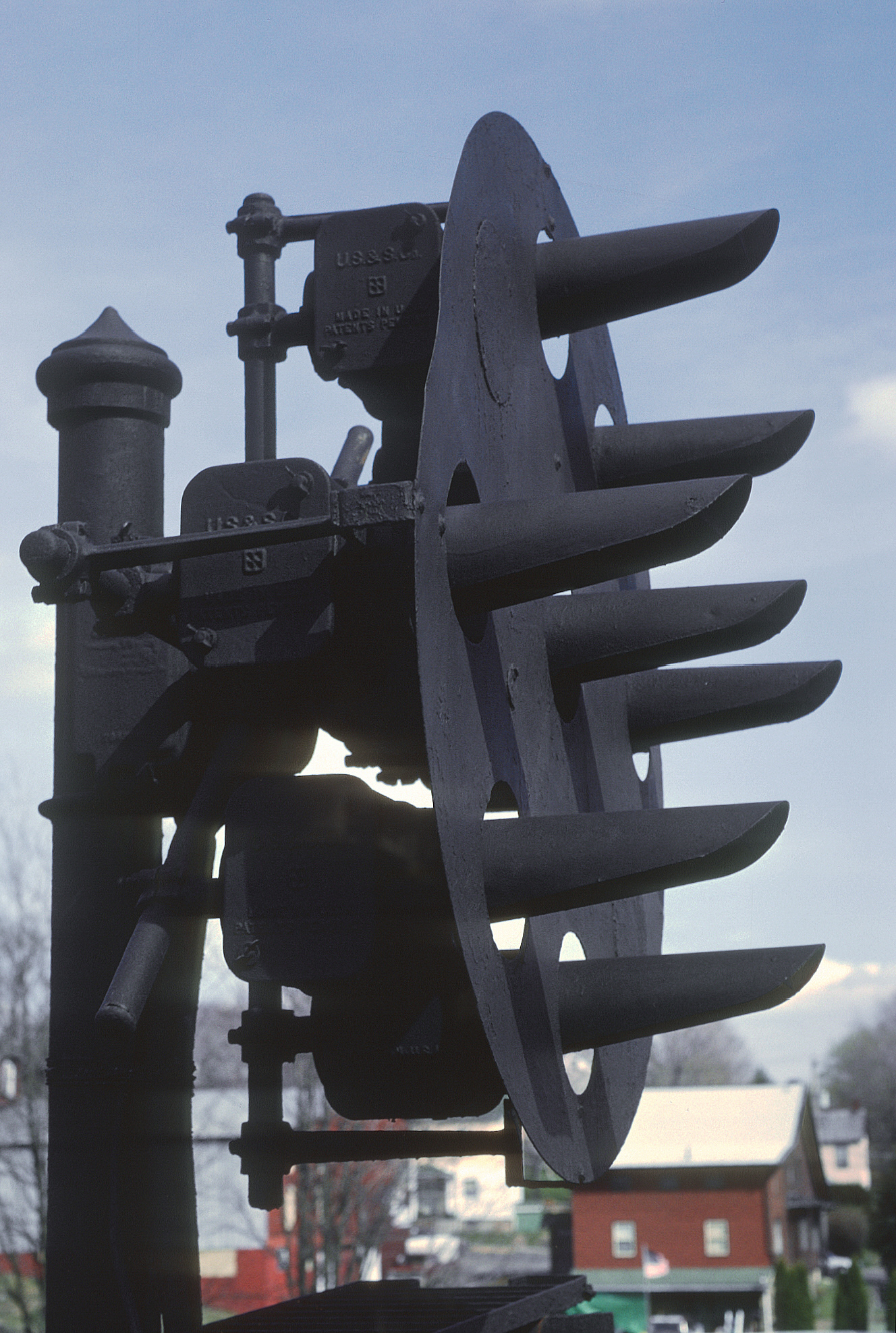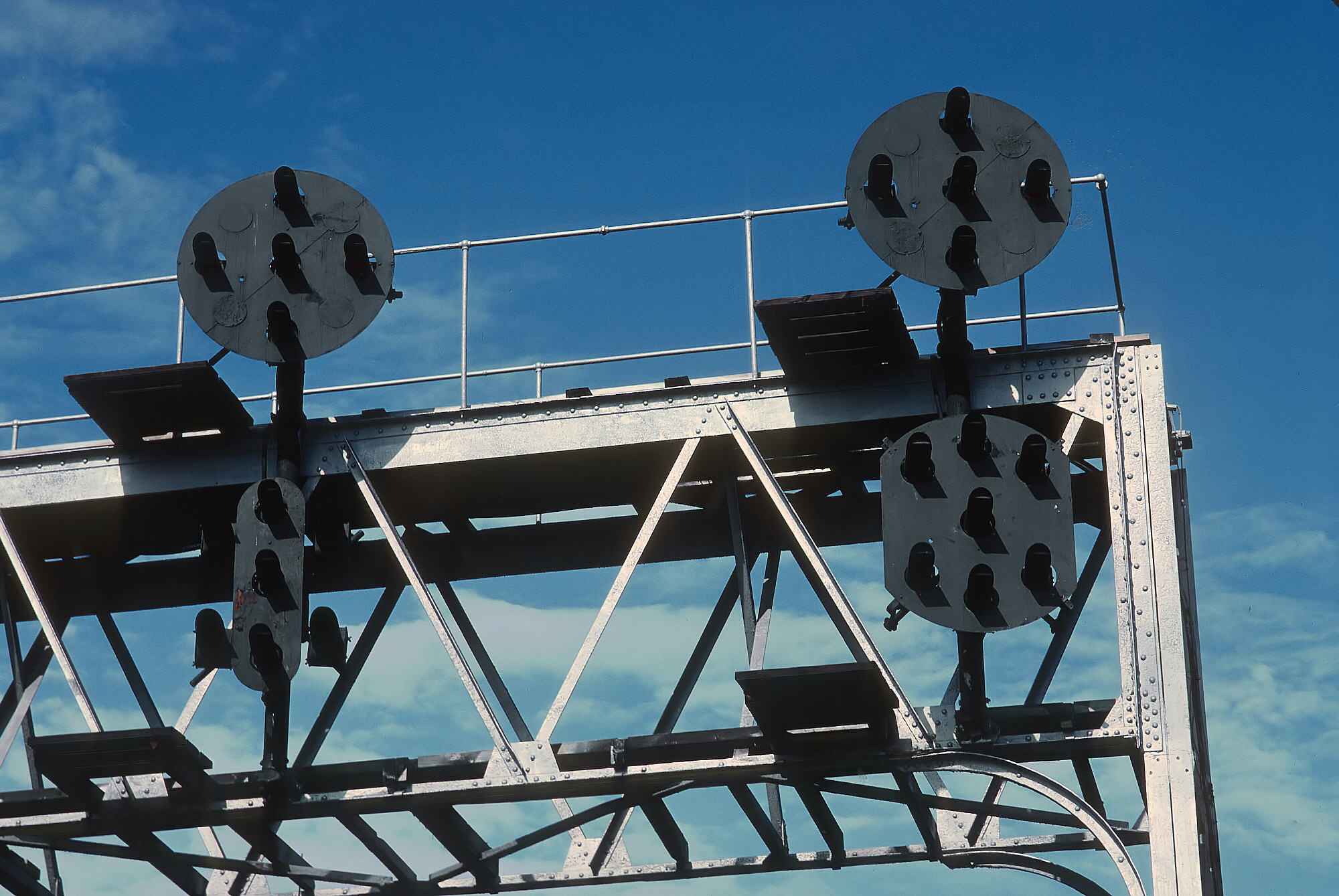Position Light Signals: PRR's Classic Design
Last revised: November 6, 2024
By: Adam Burns
The Pennsylvania Railroad (PRR), often referred to as the "Standard Railroad of the World," was instrumental in shaping the railway industry in the United States.
Among its numerous innovations, the Pennsy's position light signals stand out as a notable achievement in railroading history. These signals, with their distinctive appearance and functionality, exemplify the PRR's commitment to safety, efficiency, and technological advancement.
This article briefly delves into the history, design, and significance of the PRR's position light signals, exploring how they became an integral part of American railroading.
 A PRR position light at Cresson, Pennsylvania during the Conrail era on April 21, 1988. Roger Puta photo.
A PRR position light at Cresson, Pennsylvania during the Conrail era on April 21, 1988. Roger Puta photo.Historical Context and Evolution
The late 19th and early 20th centuries were a period of significant growth and innovation for railroads in the United States.
With increased rail traffic, the need for effective and reliable signaling systems became paramount. Before the advent of electric signaling, most railroads relied on mechanical semaphore signals, which used moving arms to convey different messages to train crews.
However, semaphore signals had their limitations, particularly in terms of visibility during poor weather conditions and at night.
The Pennsylvania Railroad recognized the need for a more advanced signaling system, capable of providing clear and unambiguous indications regardless of weather or lighting conditions.
In response, the PRR developed the position light signal, which became one of the most iconic and effective signaling systems in the rail industry.
Early Development
In 1915, the PRR conducted tests on the first version of the position light signal, which quickly earned the nickname "tombstone signal" due to its distinctive rounded top resembling an old tombstone.
This innovative concept later gained traction and was adopted by its affiliates, the Norfolk and Western Railway and the Lehigh Valley Railroad.
The PRR's engineering department sought to create a signaling system that would be easily visible and understandable under various conditions. By utilizing electric lights configured in specific patterns, the engineers aimed to surpass the limitations of mechanical semaphore signals.
Following further troubleshooting the railroad had perfected the PL's now-classic shape and configuration by 1921. The first position light signals were installed on the PRR's Fort Wayne Line between Pittsburgh and Chicago in 1924.
These initial signals proved highly successful, offering improved visibility and reliability. Encouraged by this success, the PRR gradually expanded the use of position light signals across its vast network.
Adoption and Expansion
Throughout the 1920s and 1930s, the Pennsylvania systematically replaced many of its semaphore signals with position light signals.
The widespread adoption of this signaling system was driven by its numerous advantages, including enhanced visibility, decreased maintenance requirements, and increased operational efficiency.
By the mid-20th century, position light signals had become a hallmark of the PRR's infrastructure.
They were used not only on mainline routes but also in yards, terminals, and interlocking plants. The PRR's commitment to safety and innovation solidified its reputation as a leader in the rail industry, and the position light signal became a key element of this legacy.
Design and Functionality
The PRR's position lights have a distinctive and instantly recognizable design. These signals use multiple light units arranged in specific patterns to convey different signal aspects or indications. The design was intended to be easily interpretable by train crews, enhancing safety and operational efficiency.
Basic Structure
A typical position light signal mast consists of a black metal background with several light units (usually yellow or amber) mounted on it. Each light unit consists of a single bulb housed within a circular or oval-shaped lens. The arrangement of these light units forms specific patterns or orientations, each corresponding to a particular signal aspect.
Signal Aspects and Their Meanings
The position light signal system uses various patterns to indicate different messages to train crews. Here are some of the most commonly used aspects and their meanings:
1. **Stop (Stop Signal)**
- **Pattern:** Three horizontal lights.
- **Meaning:** The train must stop and wait for further instructions.
2. **Clear (Proceed)**
- **Pattern:** Three vertical lights.
- **Meaning:** The track ahead is clear, and the train may proceed at authorized speed.
3. **Approach (Prepare to Stop)**
- **Pattern:** Diagonal lights running from the bottom left to the upper right.
- **Meaning:** The train must reduce speed and be prepared to stop at the next signal.
4. **Restricting**
- **Pattern:** A single light.
- **Meaning:** The train must proceed at a restricted speed, prepared to stop within half the range of vision.
5. **Approach Diverging**
- **Pattern:** Diagonal lights running from the bottom right to the upper left.
- **Meaning:** The train must prepare to take a diverging route at a reduced speed.
In addition to these standard aspects, the PRR's position light signals could display various other patterns to convey additional messages, depending on the specific requirements of a location or operational scenario.
 Position lights along the ex-PRR main line at South Fork, Pennsylvania on April 22, 1988. Roger Puta photo.
Position lights along the ex-PRR main line at South Fork, Pennsylvania on April 22, 1988. Roger Puta photo.Interlocking and Control
One of the key features of position light signals is their integration with interlocking systems. Interlocking plants control the movement of trains through complex track configurations, such as junctions, crossings, and switches.
The PRR's position light signals were designed to work seamlessly with these interlocking systems, providing clear and reliable indications to train crews as they navigated through potentially hazardous areas.
Interlocking systems use a combination of electrical and mechanical components to ensure that signals and switches are aligned correctly and that conflicting movements are prevented.
Position light signals, with their distinct and easily recognizable patterns, played a crucial role in this process, enhancing the overall safety and efficiency of train operations.
Advantages and Impact
The Pennsylvania Railroad's position light signals offered several significant advantages over previous signaling systems, contributing to their widespread adoption and enduring legacy.
Enhanced Visibility
One of the primary benefits of position light signals was their improved visibility. Unlike semaphore signals, which relied on moving arms and colored lenses, position light signals used electrically illuminated lights.
This made them highly visible in various weather conditions, including fog, rain, and darkness. As a result, train crews could easily interpret the signals, reducing the risk of accidents and improving overall safety.
Reliability and Maintenance
The position light signal design also offered increased reliability and reduced maintenance requirements. Mechanical semaphore signals were prone to mechanical failures and required regular maintenance to ensure proper operation.
In contrast, position light signals, with their electrically powered lights, were less susceptible to mechanical issues and could be easily maintained. This increased reliability contributed to more efficient and dependable train operations.
Operational Efficiency
The clear and unambiguous indications provided by position light signals enhanced operational efficiency. Train crews could quickly interpret the signals and respond accordingly, reducing delays and ensuring smoother train movements.
This efficiency was particularly important on the PRR's busy mainline routes, where high volumes of rail traffic demanded precise and coordinated operations.
Contribution to Safety
The Pennsylvania Railroad's commitment to safety was evident in its adoption of position light signals. By providing clear and reliable indications, these signals helped prevent accidents and collisions, safeguarding both passengers and freight.
The integration of position light signals with interlocking systems further enhanced safety by ensuring that train movements were correctly coordinated through complex track configurations.
Industrial Influence
The success of the PRR's position light signals had a lasting impact on the rail industry. Other railroads recognized the benefits of this innovative signaling system and began adopting similar designs.
The position light signal became a standard feature on several railroads, contributing to a broader trend toward electrified and illuminated signaling systems.
Legacy and Preservation
While the Pennsylvania Railroad eventually ceased operations in 1968, its legacy lives on through its contributions to railroading, including the position light signal system.
Many of the original position light signals installed by the PRR remain in use today on successor railroads, serving as a testament to the enduring quality and effectiveness of this innovation.
Preservation Efforts
Railroad enthusiasts and preservation organizations have recognized the historical significance of the PRR's position light signals.
Efforts are underway to preserve and restore these signals, ensuring that future generations can appreciate their role in railroading history.
Some preserved position light signals are on display in railroad museums, providing a tangible link to the past and educating the public about the evolution of railway signaling.
Modern Adaptations
In some cases, modern adaptations and upgrades have been made to the original position light signals to meet contemporary safety and operational standards.
For example, LED lighting technology has been integrated into some position light signals, offering improved energy efficiency and longer service life. These adaptations ensure that the legacy of the PRR's position light signals continues to play a role in modern railroading.
Conclusion
PRR's position lights stand as a remarkable achievement in the history of railroading. Developed in response to the need for improved visibility, reliability, and safety, these signals became a defining feature of the PRR's infrastructure and set a new standard for railway signaling systems.
The innovative design, enhanced functionality, and enduring legacy of the position light signals exemplify the PRR's commitment to excellence and its pivotal role in shaping the rail industry.
As we commemorate the contributions of the Pennsy, the position lights serve as a lasting reminder of the ingenuity and vision that drove the railroad's success.
Whether in their original form or through modern adaptations, these signals continue to guide trains safely and efficiently, carrying forward the legacy of the "Standard Railroad of the World" into the future.
Recent Articles
-
Arizona Christmas Train Rides In The Verde Canyon!
Nov 30, 25 11:04 AM
Come late November and December, though, the railroad transforms into a glow of lights and cheer for its seasonal holiday favorite, The Magical Christmas Journey—an evening experience that has become… -
Alabama Christmas Train Rides In Huntsville!
Nov 30, 25 10:58 AM
The Santa Train and the North Star Limited each offer their own style of holiday magic, drawing families from across North Alabama and beyond to experience the simple joy of rail travel wrapped in twi… -
Wisconsin Christmas Train Ride In North Freedoms!
Nov 30, 25 10:54 AM
Today, the Mid-Continent Railway Museum offers some of the region’s most popular holiday-themed train ride. — notably the Santa Express, Holiday Flyer and Holiday Nightcap.



